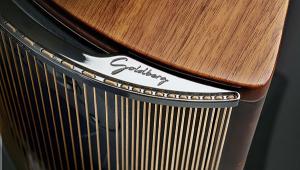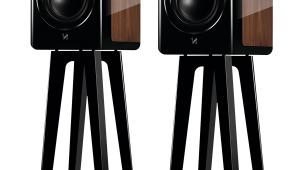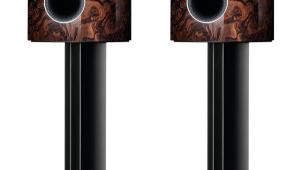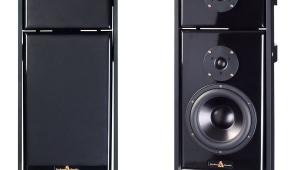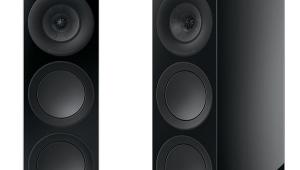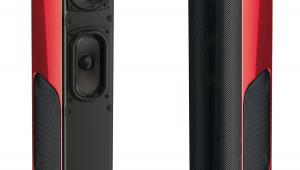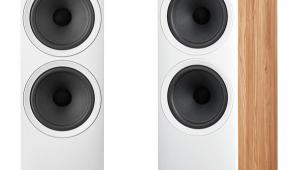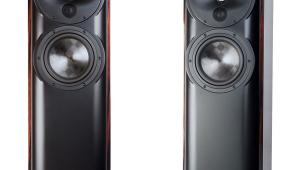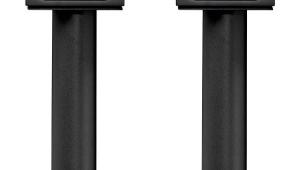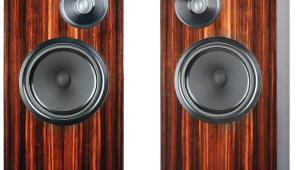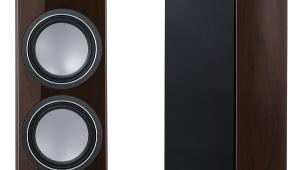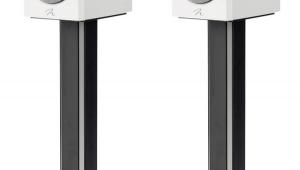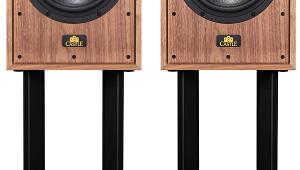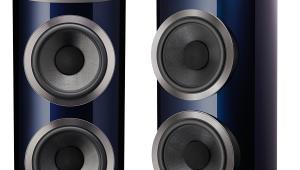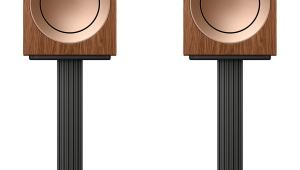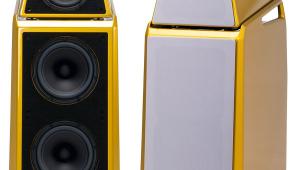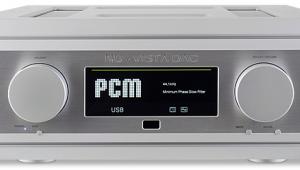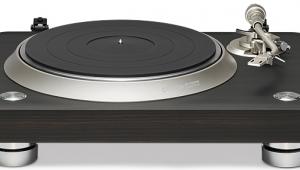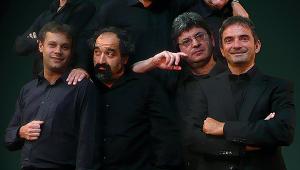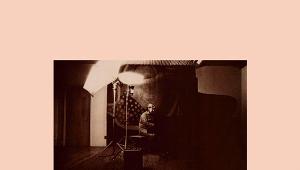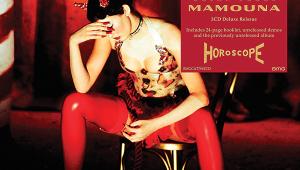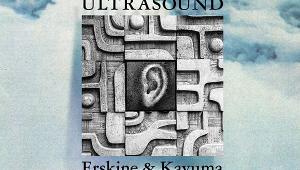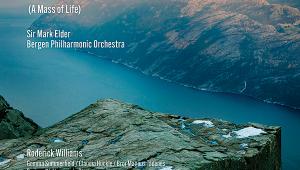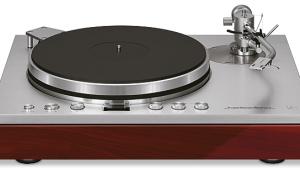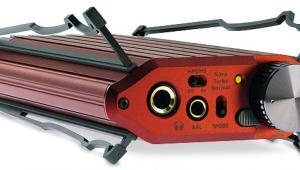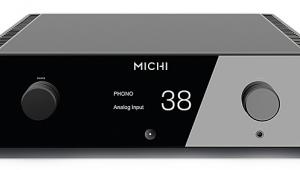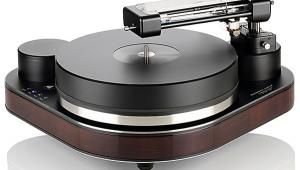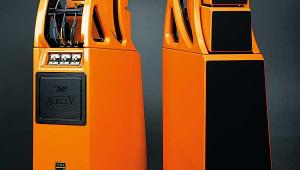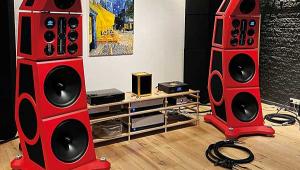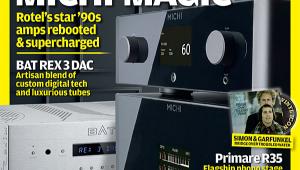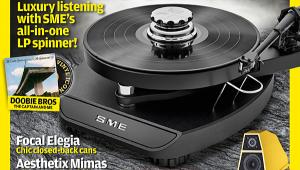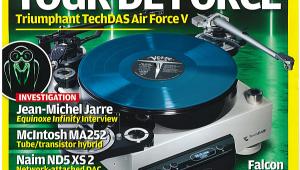Audio Physic Sitara (£1950)
Although German speaker manufacturer Audio Physic has had a low profile in the UK for some years, its name still has cachet here among those who remember its products with affection. Now back with a new distributor, C-Tech Audio, it is aiming to re-establish old friendships and forge new ones. Its three-driver, two-and-a-half-way Sitara is the new base member of its three-model High End range and does battle in the competitive market for £2000 floorstanders.
The Sitara’s key visual feature is its tall, narrow cabinet which leans backwards at seven degrees to provide time delay compensation for the displaced acoustic centres of the tweeter and bass-mid driver. Add to this the fact that the Sitara has a small footprint and a surprisingly light cabinet, so that the cluster of drivers near the top give it a high centre of gravity, and you’ll appreciate why aluminium outriggers are supplied to carry spikes and provide a wider, deeper base. Without these the Sitaras would be too easy to knock over. The spikes perform better than some I have railed against but are still not quite slim or pointy enough to achieve a truly solid link through deep carpet to the floor.
FASHIONABLE CURVES
Other features of note are that only a single pair of input terminals is provided, eliminating any possibility of bi-wiring or bi-amping, and that the cabinet side walls are curved towards the rear to allow for a rear panel that is narrower than the front. Normally I would observe that this curvature helps to stiffen the side panels but a knuckle-rap test suggests otherwise. There’s a distinct change in cabinet sound as you rap the sides from front to back, with a lower-pitched and louder response from the area of the curvature.
These curved panels should nonetheless help quell some internal standing waves but any tall, thin cabinet runs the risk of an internal ‘organ pipe’ resonance along its length. Such resonances occur too low in frequency to be revealed by our standard cumulative spectral decay waterfall (see Lab Report), so you have to look elsewhere for signs of them: for glitches in the speaker’s impedance modulus and phase curves, for instance. And yes, there is something happening in the Sitara’s impedance curves around 100Hz, confirmed by resonant ridges in the waterfalls of near-field measurements of the bass and bass-mid drivers.
SETTING THE STAGE
What impresses first about the Sitara’s sound – its stock in trade, no less – is the large soundstage it projects, which is unusually generous in both width and depth, and remarkably even in an arc from beyond the left speaker to beyond the right. Whereas some speakers achieve image depth at the centre of the soundstage but are unable to prevent it foreshortening at the image extremes, the Sitara maintains a consistent perspective across the entire vista.
This is particularly apparent on purist recordings captured in a natural acoustic. Whether it was James Griffett caressing old English songs in Boxgrove Priory [Regis RRC1112] or Kurt Elling evoking the desperation of ‘Goin’ Back to Joe’s’ in an altogether drier acoustic [Naim CD080], the Sitara portrayed both the space and the performers within it with persuasiveness. This trait alone will endear it to audiophiles who are as little impressed by the get-you-noticed, in-your-face sound of some alternatives as they are by reality TV stars.
In its product literature, on the company name badge adorning the Sitara’s front baffle and even on the adhesive tape sealing the cardboard box in which the review pair was delivered, the slogan ‘No loss of fine detail’ encapsulates Audio Physic’s design philosophy. But it isn’t easy to combine the type of portrayal I’ve just described with a presentation that oozes insight into the minutiae of a musical performance. I still had to hand the floorstanding Thiel CS1.6s that I so enjoyed recently [see HFN March ‘09]. The Thiels are about the same price as the Sitaras and the two made for a revealing comparison.
Compared to the Sitara, the CS1.6 – though it certainly achieves a spacious, box-free sound – isn’t able to convey such image scale. Its tonal balance is more forward, which reduces the sense of soundstage depth but pays dividends in the areas of detail retrieval and dynamic snap. I referred in my review to the CS1.6s’ lucidity, and that’s just the characteristic that struck me anew when I reconnected them. By comparison the Sitara’s portrayal is tonally warmer and spatially larger but more recessed, so that it sounds less explicit. A corollary in my room was that it also lacked some of the Thiels’ tunefulness in the upper bass, which may be a consequence of the Sitara’s hump in output between 100 and 300Hz. In other rooms this may manifest itself differently, but it’s a factor to bear in mind.
TOEING THEM IN TO TASTE
Does this mean that the Sitara is lo-res? No, just that it has a softer, less insistent way with midrange detail. In the treble it transitions to being crisper and more forthcoming, to the extent that vocal sibilants can sometimes be a little emphasised. But this adds drive and pace to material with strong percussive content, and can in any case be ameliorated by, as Audio Physic suggests, toeing in the speakers less than completely towards the listening position. With this adjustment you can fine-tune the tweeter’s contribution.
Which of these two disparate ‘takes’ on music reproduction you prefer will depend on personal taste and other system components. I thrive on the Thiel’s lucidity – that word again – but I can well appreciate that the Sitara’s alternative, less forceful world view will appeal to those who prize generous dimensionality and a more understated presentation. Enthusiasts can be grateful to have the choice.
VERDICT
Elegant and meticulously finished, the slim Sitara will win most friends among listeners whose taste is not for a sharply etched, obviously detailed sound but a delivery which is softer, subtler and generously spacious. Imaging is deep and wide while careful adjustment of toe-in allows the tweeter’s contribution to be fine-tuned to taste.
Originally published in the June 2009 issue
